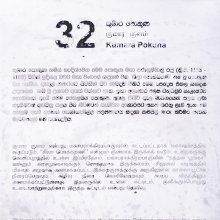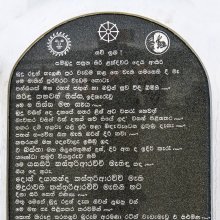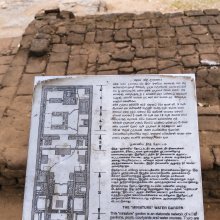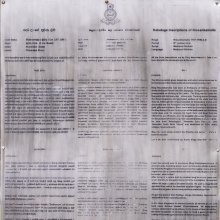Laba, Lāba, Lābā: 10 definitions
Introduction:
Laba means something in Hinduism, Sanskrit, Marathi, Hindi, biology. If you want to know the exact meaning, history, etymology or English translation of this term then check out the descriptions on this page. Add your comment or reference to a book if you want to contribute to this summary article.
Images (photo gallery)
(+2 more images available)
Biology (plants and animals)
Source: Google Books: CRC World Dictionary (Regional names)1) Laba in India is the name of a plant defined with Bauhinia malabarica in various botanical sources. This page contains potential references in Ayurveda, modern medicine, and other folk traditions or local practices It has the synonym Pauletia acida (Korth.) Hassk. (among others).
2) Laba is also identified with Bauhinia semla It has the synonym Phanera retusa Benth. (etc.).
Example references for further research on medicinal uses or toxicity (see latin names for full list):
· Flora Indica (1832)
· Linnaea (1841)
· Prodromus Systematis Naturalis Regni Vegetabilis (1825)
· Fl. Bras. (Martius) (1870)
· Hortus Bengalensis (1814)
· Flora de Filipinas (1837)
If you are looking for specific details regarding Laba, for example extract dosage, health benefits, diet and recipes, chemical composition, side effects, pregnancy safety, have a look at these references.

This sections includes definitions from the five kingdoms of living things: Animals, Plants, Fungi, Protists and Monera. It will include both the official binomial nomenclature (scientific names usually in Latin) as well as regional spellings and variants.
Languages of India and abroad
Marathi-English dictionary
Source: DDSA: The Molesworth Marathi and English Dictionarylaba (लब).—f Errand-business, message-bearing, going on errands or messages. v kara, māra. 2 unc ( P) A lip. Ex. kāgada laba lāvūna sārakhā phāḍalā. The sense Errand-business is probably from this sense Lip, implying The utterance or oral commission of the master. The sense Errandry is common, the sense Lip all but unknown. It is preserved however in some figurative or fanciful applications; as ghēṛyācī laba The lips (meeting place) of the circle of hair formed around the roots of the śēṇḍī; miśāñcī laba The lips (meeting place) of the mustaches. laba khāṇēṃ To bend, yield, give way--a beam, rafter &c. (In this phrase the word is from lapaṇēṃ) labēcā That is entertained for errands and messages.
Source: DDSA: The Aryabhusan school dictionary, Marathi-Englishlaba (लब).—f Errand–business.
Marathi is an Indo-European language having over 70 million native speakers people in (predominantly) Maharashtra India. Marathi, like many other Indo-Aryan languages, evolved from early forms of Prakrit, which itself is a subset of Sanskrit, one of the most ancient languages of the world.
Sanskrit dictionary
Source: DDSA: The practical Sanskrit-English dictionaryLaba (लब).—Ved. A quail.
Derivable forms: labaḥ (लबः).
--- OR ---
Lāba (लाब).—A sort of quail.
Derivable forms: lābaḥ (लाबः).
See also (synonyms): lābaka.
Source: Cologne Digital Sanskrit Dictionaries: Shabda-Sagara Sanskrit-English DictionaryLāba (लाब).—m.
(-baḥ) A sort of quail; also with kan added, lābaka .
Source: Cologne Digital Sanskrit Dictionaries: Cappeller Sanskrit-English DictionaryLaba (लब).—[masculine] a cert. bird.
--- OR ---
Lāba (लाब).—[masculine] a kind of quail.
Source: Cologne Digital Sanskrit Dictionaries: Monier-Williams Sanskrit-English Dictionary1) Laba (लब):—m. a quail, [Vājasaneyi-saṃhitā]
2) (with aindra) Name of the supposed author of [Ṛg-veda x, 119; Anukramaṇikā]
3) Lāba (लाब):—m. (often written lāva) Perdix Chinensis, [Rāmāyaṇa; Suśruta] (also f(ā). )
4) a [particular] gait, [Saṃgīta-sārasaṃgraha]
[Sanskrit to German]
Sanskrit, also spelled संस्कृतम् (saṃskṛtam), is an ancient language of India commonly seen as the grandmother of the Indo-European language family (even English!). Closely allied with Prakrit and Pali, Sanskrit is more exhaustive in both grammar and terms and has the most extensive collection of literature in the world, greatly surpassing its sister-languages Greek and Latin.
Hindi dictionary
Source: DDSA: A practical Hindi-English dictionaryLaba (लब) [Also spelled lab]:—(nm) lip; brim; rim; edge; bank (of a river etc.); ~[reja] full to the brim; -[e-dariyā] on the bank of a river; -[e-saḍaka] by/beside the road, on the road-side; -[o-lahajā] delivery, manner of speaking, —[khuśka honā] the lips to get dried up; to be scared mute; —[kholanā] to speak out; —[para ānā] to find expression; to be on the verge of being expressed; —[sīnā] to be tongue-tied, to keep quiet; [laboṃ para dama ānā] to be on the verge of death.
...
See also (Relevant definitions)
Starts with (+36): Labaarchotta, Labaasaatso, Lababa, Lababheshai, Labada, Labadadhomdhom, Labadajhabada, Labadaki, Labadalacada, Labadaru, Labadi, Labadilacadi, Labadiya, Labadu, Labaho, Labai, Labaja, Labak, Labaka, Labakanem.
Ends with (+40): Abalaba, Ailaba, Alaba, Amafuthomhlaba, Aramatalaba, Ausata-talaba, Balaba, Ballidurlaba, Bashpaviklaba, Bematalaba, Bitalaba, Calophyllum calaba, Chelaba, Dalaba, Darraba salalaba, Dulaba, Fulaba, Galaba, Gulaba, Gulagalaba.
Full-text: Labam, Labasukta, Kongngouyen laba, Labanka, Labai, Labakshaka, Labaksha, Labaka, Ureirom-laba, Dapatashaha, Kongngouyen-laba, Lava, Alabu, Lavaka, Dada, Lapa, Rabh.
Relevant text
Search found 6 books and stories containing Laba, Lāba, Lābā; (plurals include: Labas, Lābas, Lābās). You can also click to the full overview containing English textual excerpts. Below are direct links for the most relevant articles:
Rig Veda (translation and commentary) (by H. H. Wilson)
Rasa Jala Nidhi, vol 4: Iatrochemistry (by Bhudeb Mookerjee)
Part 5 - Treatment for fever with diarrhea (4): Kanaka-prabha rasa < [Chapter III - Jvaratisara fever with diarrhoea]
Part 10 - Things beneficial in chronic fever < [Chapter II - Fever (jvara)]
Part 2 - Dietary prescriptions < [Chapter I - General health prescriptions]
Rasa Jala Nidhi, vol 3: Metals, Gems and other substances (by Bhudeb Mookerjee)
Part 14 - Dietary presecriptions and prohibitions when taking iron < [Chapter IV - Metals (4): Lauha (iron)]
Rasa Jala Nidhi, vol 5: Treatment of various afflictions (by Bhudeb Mookerjee)
Chapter 15 - Symptoms and treatment of Chardi (vomiting)
Chapter 20 - Symptoms and Treatment of Madya-pana-vikara
Chapter 4 - Symptoms and treatment of Asthma (shvasa) and Cough (hikka)
Vernacular architecture of Assam (by Nabajit Deka)
Mahabharata (English) (by Kisari Mohan Ganguli)
Section XIV < [Anusasanika Parva]





